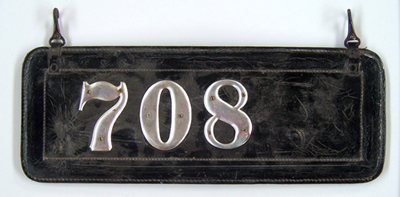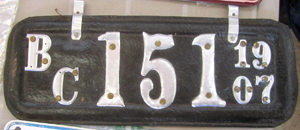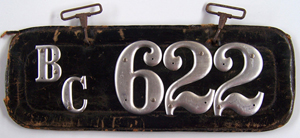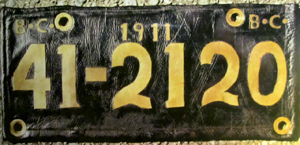|
British
Columbia Passenger License Plates
|
||||||||||||||||||||||||||||||||||||||||||||||||||||||||||||||||||||||||||||||||||||||||
Quick Links: |
1904-12 sub-Links: |
| A Plague Upon Our House! |
An unfortunate aspect of the leather plates from the pre-provincial era in British Columbia is that many of the examples that exist today are viewed with a skeptical eye by most serious collector's due to the prevalence of "reproductions" that have been made in recent decades with surplus parts and pieces that survived the era. |
 |
 |
Examples of surplus materials from the pre-provincial era still in existence |
|
The following is a cautionary tale for anyone looking to add a plate from this period to their collection and underlines the old legal maxim of caveat emptor ("buyer beware") and the need to do one's homework. So, let's start with what appeared on a popular on-line auction web-site in April of 2012: |
 |
This rare plate was very recently discovered at the rear of an antique shop in Western Canada. It was made pre-1913 when British Columbia switched to porcelain on steel plates. The leather is in extremely good condition and the item is 16 inches long by 6 inches. Sherlock Holmes enthusiasts with an eye for detail will see that the zero number actually covers evidence of the existence of an 'eight' that has left it's mark in the leather. Why the 'eight' has been removed and a zero affixed is part of the Post-Victorian mystery that goes with this plate. So the actual number is believed to be 788, and that number was issued to the registrant in 1910. Another fascinating feature are the strange looking security fixtures attached to the bolts. These would effectively prevent removal of the metal characters. The number zero has been attached with two nuts and bolts. This plate is quite a conversation piece and has survived better than average. |
What's not to like, right? It sounds like the kind of find that any license plate collector dreams of making - walk into the back of a dusty old antique store and lo-and-behold, a rare leather license plate that hasn't been seen before! Sure the missing number that has been replaced by a new (?) '0' is somewhat fishy ... but considering how rarely these come up for sale, this can be overlooked, can't it? Unfortunately, not everything is as it seems with this particular plate ... |
One of the things that the crew here at BCpl8s.ca likes to do is photograph as many BC license plates as is possible, and one of our favourite hunting grounds is the annual Pacific Northwest Regional License Plate Meet that is held in Burnaby each March. Collector's from across the province and even from surrounding jurisdictions such as Alberta and Washington attend this meet and bring thousands of plates with them. |
The 2010 Meet provide to be an exceptionally good venue for plates from the pre-provincial era and we were able to photograph a few good specimens, many of which are shown at the top of this page. We were also able to snap a picture of a plate that we were told - by other respected members of the plate collecting fraternity - was a likely reproduction. The plate in question was the No. 708 (shown below-left). |
The No. 708 as it appeared at the 2010 Pacific Northwest Regional Meet. |
The No. 708 as it appeared the week before the
2012 Pacific Northwest Regional Meet. |
Who can spot the problem here? Right, apart from the base having been cleaned, the letters 'BC' have been added to the plate sometime in the intervening two years since it had last been spotted at the 2010 Burnaby Meet. By clicking on the image of the plate as it appeared in 2010 (above-left) it is possible see that there are actually no holes on the plate to accommodate the placement of these letters. |
A little known aspect of the early history of vehicle registration in British Columbia is that neither the 1904 "Act to regulate the speed and operation of Motor Vehicles on Highway" or the 1911 "Act to regulate the Use and Operation of Motor-vehicles" required any identifying letters be included with the "permit" number that had to be displayed on each vehicle. |
 BC Archives (E-00963) |
|
 Saanich Archives |
Shown above are the two first licence plates used in British Columbia (i.e. the No. 1 at left and visible under the driver's seat; and the No. 2 clearly visible on the front grill of the vehicle), as well as the No. 689, which would have been issued in 1910. As is evident in these photos, not all plates from the pre-provincial era displayed the ubiquitous letters of "BC", whereas in the photo shown below, the "BC" beside the No. 2384 is readily apparent.
|
||
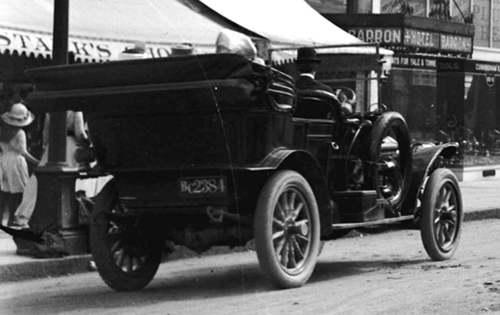 Vancouver Public Library |
||
It is not clear when the custom of attaching the letters "BC" to home-made plates started in the pre-provincial era (we here at BCpl8s.ca are still working on this question), but it was certainly not uncommon by 1910 and would continue through to March of 1913 when the first standardised provincial plates would begin to be issued. In fact, it is only after the newly amended "Motor-traffic Regulation Act" was implemented on March 1, 1913 that licence plates were required to display "the licence number of such motor, the initials 'B.C.' [emphasis added], and the year of issue." |
 |
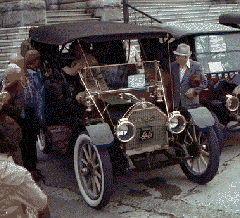 |
The difficulties associated with identifying plates from the pre-provincial era is best exemplified by the case of No. 45. While we have no reason to doubt its authenticity, this particular plate sold at a recent Burnaby meet as a motorcycle plate (which is why it is displayed on the Motorcycle page of this web-site), however, it has been used in the past as vintage plate on an automobile (sorry for the poor picture quality of the adjacent image, but if you look closely the No. 45 plate can be seen on the front grill between the two headlights). So, is this a motorcycle plate, or an automobile plate? It could be either, and as with the other very early pre-provincial plates shown above, the letters "BC" are absent. |
In fairness, this does raise a legitimate question as to whether the No. 708 is possibly legitimate? After all, the absence of the letters "BC" would have been wholly consistent with the requirements of the 1904 legislation, and the subsequent addition of these letters can be chalked up as nothing more than a rather unfortunate act by an uninformed collector. |
While possible, we think this doubtful and would point to the odd placement of the numbers in, what appears to be, the intentional leaving of space for the anticipated attachment of letters at some future point (why the letters never made it on will probably remain a mystery). However, in other photos of plates from this era where the letters "BC" have not been attached, the numbers have been centred in the middle of the plate - not offset as is seen on the No. 708 (as it appeared in 2010). |
There is also the troubling question that, in the absence of identifying letters - and if this plate is legitimate - did it even originate in British Columbia? One could argue that the leather base bears a striking similarity to the one's used in other jurisdictions, such as Nebraska (for a more thorough archive of plates from the leather era, check out LeatherLicensePlates.com). |
At a minimum, all of these points - from the unknown origin of the base to the inclusion of the letters "BC" - should have been identified in the description of the plate when it was being offered for sale. |
Fortunately, due to our photographic proclivities and tendency to ask collector's for images of plates from their collection, we are able to shed some additional light on this particular plate that, we would argue further casts its origins in doubt. |
We have been told that the tale about finding the plate in an antique shop is correct, but that it turns out the plate was on consignment by the fellow who had brought it to Burnaby in 2010. Not aware of who the seller was (and that the plate had previously been photographed by a number of people), the protagonist of this story purchased the plate and put forward the story about it being recently "found". |
The issue of the missing "BC" letters was addressed by removing some letters from a known reproduction and affixing them to the No. 708 in order to make the plate more authentic and desirable. To ensure that the addition of these letters would not readily detectable, the fasteners used to secure the numbers '7' and '8' were all replaced with the same one used to attach the letters 'B' and 'C' (the '0' was left as is as it had already been conceded to be a replacement): |
Other collector's were unwittingly used to confirm 1910 as the date of issue for the registration number (the protagonist had initially pegged the date as 1907 when attempting to sell the plate prior to listing it on eBay). |
And Voila, a plate that might have fetched $50 to $100 as a nice reproduction is instantly worth $1,750 USD and an apparently unsuspecting collector from out of province has been separated from a fairly sizeable chunk of change. Maybe the purchaser of this plate knew what they were getting and wasn't too fussed by it, but will the next person? |
When buying license plates on-line ensure that you have done your homework, ask lots of questions, and ask other collector's for help or advice if you are unsure! |
* * * * * |
 A story told to this writer many years ago by (the now late) Bob
Miller is that when a local company with a long history of servicing automobiles
in the Victoria area ceased operations and their premises were cleaned out, found inside were original materials
used for producing license plates in the pre-provincial era including leather bases; numbers 1 through 9; and
the letters 'B' & 'C'. Shown at right is a sample Bob made with these materials. A story told to this writer many years ago by (the now late) Bob
Miller is that when a local company with a long history of servicing automobiles
in the Victoria area ceased operations and their premises were cleaned out, found inside were original materials
used for producing license plates in the pre-provincial era including leather bases; numbers 1 through 9; and
the letters 'B' & 'C'. Shown at right is a sample Bob made with these materials. |
The "sample" plate shown above was not the only plate made using these materials. Other plates came into being this way, including the No. 245, which showed up on an on-line auction site in late September of 2019: |
 |
The auction described the plate as follows: |
This is a beautiful British Columbia Leather Plate from 1907. Based on Government information the number sequences for 1907 were #115 to 275. Very Rare to find this plate. The craftsmanship on this plate is wonderful. The Canadian province of British Columbia first required its residents to register their motor vehicles in 1904. Registrants provided their own licence plates for display made mostly from wood and leather. The province began to issue plates in 1913. Clean plate with no rubs and no rust. Check pictures. |
Now, we don't claim to know what the seller knew about the provenance of this plate before listing but we do note that there is no reference to its origins in the auction description and we also know that this particular plate/number had been listed on BCpl8s.ca since 2012 as a known reproduction. |
We know this because the person who acquired the plate from Bob Miller confirmed to us the details of its origin! Bob Miller had made the No 245 plate from the excess materials he had acquired from the closed service station and this fellow purchased the plate from him in the early 1990s. |
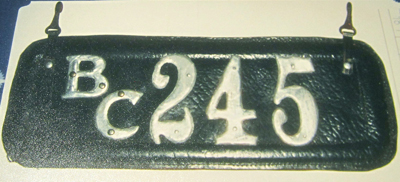 |
 |
Photos of the purported BC license plate "No. 245" taken in the 1990s |
|
This collector further advised us that he held onto the plate for about 10 years before trading it to another collector on Vancouver Island who, himself held onto it for about 5-10 years before it found its way to another BC collector who acquired the No. 245 believing it to be authentic. The ownership of the plate between 2013 and appearing on eBay in 2019 is unknown. |
Long story short, the No. 245 leather plate was never used on a vehicle between 1907-12 and is a reproduction made many decades later. |
Again, we reiterate the advise we provided seven years ago in relation to the No. 708; when buying license plates on-line ensure that you have done your homework, ask lots of questions, and ask other collector's for help or advice if you are unsure. In closing, we leave you with some other photos of the No. 245 through the years: |
 |
 |
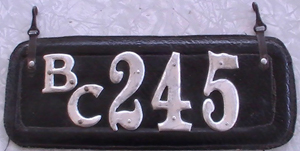 |
Photos of the purported BC license plate "No. 245" taken over the years |
||
| Real or Reproduction? |
The purpose of this exercise is not to cast aspersions anyone particular plate so much as it is an attempt to demonstrate the difficulties associated with identifying genuine BC pre-provincial plates from the 1904-1912 period. Examine the following specimens and drawn your own conclusions: |
| This is one of a series of reproductions that were made in the early 1990s by a fellow in the Kootenay's. These were identified as reproductions at the time they were initially sold but, as occurs over time, certains details are forgotten or lost and these reproductions take on a new signifcance. It is thought that there might be about a dozen of similar looking plates floating around. | |
| These one's almost defy explanation, especially as they are reverse sides of the same plate! Out of interest, reference to the 1904 Register reveals that the No. 151 was issued to an A. MacDonald of Vancouver on May 7, 1907, and the No. 200 to Charles Jones, also of Vancouver on July 2, 1907 (a mere two months apart). While undoubtedly a genuine leather base (possibly even from BC), and era letters (i.e. "BC") and numbers (i.e. "1907"), the No. 151 appears to have been hammered out by hand to resemble characters common to the era, while the paint on the No. 200 speaks for itself - not even scuffed by the fasteners used to affix the registration number on the other side. Remember, the practice of including a date is not common to this era, and it has also not yet been established as to when the practice of attaching the letters "BC" to plates became the norm (as it certainly wasn't in 1904). |
|
 |
This is one of a series of reproductions that were made in the early 1990s by a fellow in the Kootenay's. These were identified as reproductions at the time they were initially sold but, as occurs over time, certains details are forgotten or lost and these reproductions take on a new signifcance. It is thought that there might be about a dozen of similar looking plates floating around. The inclusion of the year is also unusual and, in this instance, bears no relationship to the date the No. 216 would have been issued, which was 1907. |
 |
This is one of a series of reproductions that were made in the early 1990s by a fellow in the Kootenay's. These were identified as reproductions at the time they were initially sold but, as occurs over time, certains details are forgotten or lost and these reproductions take on a new signifcance. It is thought that there might be about a dozen of similar looking plates floating around. |
| This is a trickier one as the materials used are consistent with those from the era, however, the condition of the base appears to be in poorer shape than the letters and numbers. | |
 |
This is a confirmed reproduction using "New Old Stock" (NOS) materials from the era but which was made many decades later by an old car guy who wanted a plate from the period to use on his vehicle. Had this not been confirmed by the current owner, it would have been one of those plates that would have been very difficult to authenticate. |
| Apart from the base, the materials used to make the date and numbers (as well as the dualing "B.C.") are no characteristic of the era. The number also bears no relation to those issued between 1904 and 1912. Safe to conclude that this is a reproduction. |
Quick Links: |
1904-12 sub-Links: |
Antique | APEC | BC Parks | Chauffeur Badges | Collector | Commercial Truck | Consul | Dealer | Decals | Driver's Licences | Farm | Ham Radio | Industrial Vehicle | Keytags | Lieutenant Governor | Logging | Manufacturer | Medical Doctor | Memorial Cross | Motive Fuel | Motor Carrier | Motorcycle | Movie Props | Municipal | National Defence | Off-Road Vehicle | Olympics | Passenger | Personalized | Prorated | Prototype | Public Works | Reciprocity | Repairer | Restricted | Sample | Special Agreement | Temporary Permits | Trailer | Transporter | Veteran | Miscellaneous |
© Copyright Christopher John Garrish. All rights reserved.

